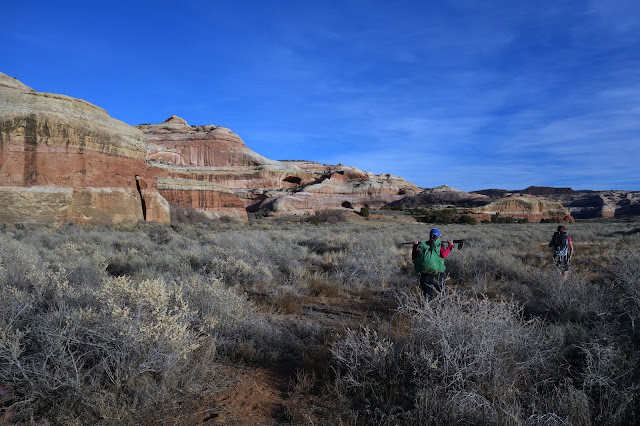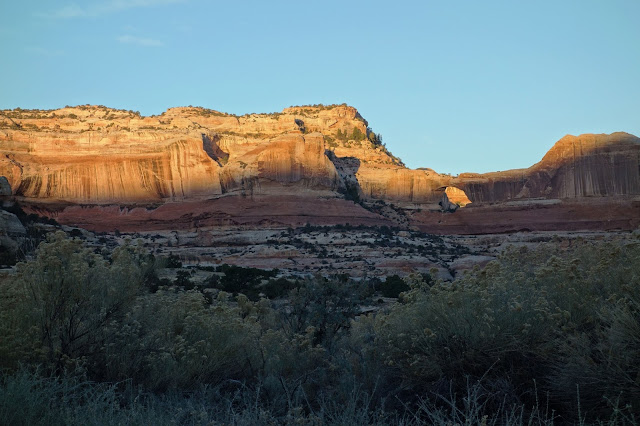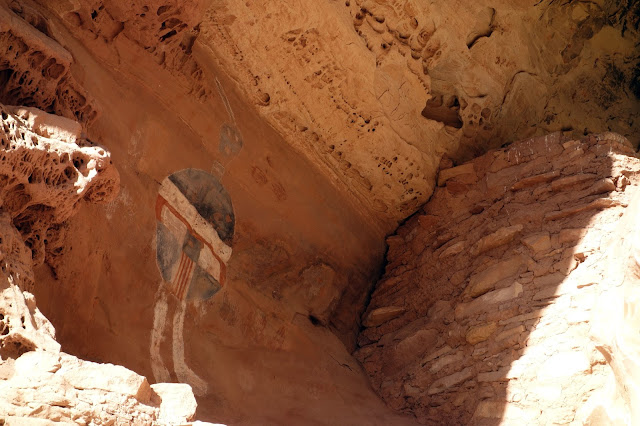I couldn't tell you how many times "back in the day" came up this weekend. Probably enough that Danni and Meghan quietly rolled their eyes while I recounted the Upper Black Box trip where Curt threw his pack down the 100-foot cliff that my college friends and I were carefully down-climbing, and all of his Nalgene bottles exploded. I can't help it. A piquant aroma of sagebrush fills the air, heat radiates from sandstone in November, and in my senses I'm 22 years old again, adrift in memory. It almost doesn't matter that this was a different era, when I was a different conglomeration of cells, "back in the day." Although time is linear, our experience of time is not.

Six or seven years ago, Danni and Meghan started what they hoped would be an annual gathering of friends for wanderings in the wilderness. With the tendency of modern women to be self-deprecating about our passions, they called it "Fat Camp," and started inviting other female friends to join. I tagged along for their Wind Rivers trip in 2015, but time has been seemingly in short supply for everyone since. Finally an opening came up for just the three of us over Thanksgiving weekend so we grabbed it, even though it meant inviting Danni to my family dinner and rushing south immediately after pie was served. We had a short three days but we intended to make the most of it, hiking in the Needles District of Canyonlands National Park.

For planning and acquiring permits at the last minute — she texted me Wednesday afternoon, as I was driving from Colorado to Utah, with the question "do you have a high-clearance vehicle?" — Meghan put together a stunning route: a one-way trip down Salt Creek Canyon. With fields of rare grass and a couple of year-round springs, the canyon is a relative oasis in the Utah desert. Our daily required mileage was short and side-canyon possibilities were many, with an abundance of archaeological sites to explore.

After a lazy car-camp morning, acquiring permits at the visitor center, chatting with the amicable couple who own the Needles Outpost, and driving the shuttle, our hike didn't begin until a few short hours before sunset on Friday. Luckily we only had four miles to walk to our first camp. When I was 22, four miles seemed like a sufficient day of hiking, and you know what — it still does. At mile three, we passed a cabin built by Rensselaer Lee Kirk, a rancher who ran cattle up Salt Creek in the 1890s. Outside were the remnants of a wagon that may be the one he used to haul supplies from Moab, and that had to be broken down and ferried up an eroded pour-over called Big Jump. We circled through the interior of the cabin, admiring its solid construction with hand-planed logs. It was easy to imagine what Kirk's home life might have been like, on a warm summer night with the desert wind rustling cottonwood leaves outside. I pictured an iron pot of beans cooking in the sandstone fireplace. The howling of coyotes might be the only sound to break a silence that stretched for hundreds of miles.

Despite the late start, 90 minutes of hiking put us into camp with daylight to spare, so we ventured up a side canyon in search of ruins. We bashed through the sage and followed erratic deer trails, skipping around fragile patches of cryptobiotic soil as though they were molten lava. We also dodged petrified cow pies, perfectly preserved even though cattle haven't trampled this canyon in more than 40 years.

Besides a myriad of deer tracks, we began to see distinct kitty tracks. We guessed a larger mountain lion followed closely by a juvenile, climbing out of the wash and circling back. They were well-defined compared to most of the deer tracks we saw, which meant they were fresh. Collectively we acknowledged that instinctual chill running down our spines. A setting sun but also nervousness prompted us to turn around. Not ten minutes later, Meghan called out, "Mountain lion! Over there!" We stopped and looked toward the hillside, where a large animal was sprinting parallel to our path. The animal had a long tail and broad head, with golden fur that glistened in the afternoon light. Its body turned light gray as it entered the shadows, where it stopped and turned to face us. It was less than a hundred meters away, and large enough that its head peeked over waist-tall sagebrush that dotted the canyon.
"Maybe it's a fox," Meghan suggested, in that uncertain tone people use when they're trying to explain away certain fear.
"That is not a fox," I replied, and squinted at the lion until I was certain I could see its gaze piercing mine, communicating our undisputed places in the food chain. It turned again and ran along a row of juniper trees, stopping twice more to look toward us before disappearing over the hillside. We had to cross its prior path to return to our campsite, so we had no choice but to continue forward.
"Let's stick close together," Danni suggested.
Despite primal nervousness, we couldn't help our human curiosity to explore a cliff dwelling on the way. The structure was built by the Ancestral Puebloans more than 700 years ago. As early farmers, they lived year-round in the canyon while cultivating maize, beans, and squash. Their stone houses and granaries are still largely in tact, scattered with pottery shards and centuries-old corn cobs. It wasn't so easy to imagine their home lives, huddled in these oven-like alcoves under a searing summer sun, carrying spring water in clay pots as they scaled sheer standstone walls with baffling agility.

Seven hundred years later, the alcove that held these ruins was by far the warmest place in the canyon. Even with a mountain lion lurking close by, we wished we could relocate as we descended into a sink of freezing air that surrounded our tents. The sun disappeared as we sought out the nearby spring to collect water. We passed a sandstone window that was listed only as "natural arch" on our map. "We'll call it Cougar Mouth Arch," I suggested.
The sun was gone at 5 p.m. By 7, the temperature was freezing and frost was already forming on my neglected cup of tea. Danni announced she was ready to crawl into her sleeping bag, and I knew we had a least 12 idle hours ahead. I don't often sleep through a night, and feared it was going to be a long one, but I was grateful as well. Beyond unpolluted desert air, the sky was filled with stars upon stars. Silence was absolute. I remembered many quiet nights in the desert before cell phone reception. I could happily go weeks without, now.

In the short minutes between dinner and lights out — perhaps in an attempt to keep conversation flowing beyond an unconscionably early bedtime — Meghan asked the question, "What's the worst thing about aging?" All that came to my mind was, "I wish I still felt the way I did in 2014." I wasn't even that much younger then. Those are just my most recent memories of a time when I consistently felt healthy and strong, and still clung to a belief that limits were negotiable tricks of the mind. Now my imagination is often my best escape from physical limits, which are definitely real, and possibly permanent. My body's chemical balance has shifted and I'm certainly not the same conglomeration of cells. Yet life remains amazing. If I'm lucky enough to continue experiencing wonder at age 50, 60, 70, I will rejoice. I'm not 22 years old anymore, and it doesn't really matter.

The following morning, we 'shwacked through a horror maze of rabbit brush to view rock art that Meghan's eagle eye spotted from a fair distance. I've prided myself on retaining 20/20 vision into my late 30s, but Meghan's undoubtedly exceeds mine. Like many, I find ancient rock art utterly fascinating — for the unlikely environment in which it was created, the even more unlikely way it lasted, and the unanswerable questions about its meaning. This panel might portray a simple illustration of one's family and directions to the spring, or it might convey the existential ruminations of an ancient restless soul. Across centuries these communications have been obscured, and yet they leave a powerful impression.

A bit off trail and out of the way, this site was filled with interesting pottery shards. Survival in this canyon was undoubtedly hard — cultivating crops in the arid soil, constantly exposed to extreme heat, wind, and cold, scaling treacherous walls just to access shelter — yet the Ancestral Puebloans clearly spent a lot of time making art. The value of art feels somewhat lost in modern society, where most of the billions of us prefer effortless entertainment and arbitrary achievement to "frivolous" acts of creation. If I needed to scratch seeds from the sand just to live another day, would I still feel compelled to scrawl hand-ground pigments onto rock and express my inner longings? I suspect I would.

It's interesting how one can look at something as simple as the outline of a hand print and think, "I see you," and perhaps imagine an entire narrative of moments surrounding their creation.
Meanwhile we continued walking, heavy packs pressing down on our shoulders, with the warm November sun radiating off rock and jaw-dropping formations appearing around every corner. In these moments, I could imagine that ancient life would not be so bad.

We were constantly in awe of the Puebloans' apparent climbing abilities. This granary was some 35 feet above the canyon floor. It may have had a ladder, but it also might just have been accessible via this sandstone chimney, which Meghan demonstrated was likely an easy shimmy if one was fit and not necessary frightened about slipping and falling on the way down. She and Danni spent about a half hour playing with possibilities while I sat by idly, perfectly content to not do any scrambling. At 22 I was braver, more willing to rappel down a wall on a rope harness or friction climb near-vertical slickrock. Eventually anxiety, not to mention a few close calls, caught up with me. I've since accepted that some of us have a more volatile relationship with gravity, and we live on by not trying to be heroes to ourselves.

We walked around the corner from the chimney granary, and collectively gasped. The next feature was the famous "All-American Man," a stunningly bright shield motif painted in blue, red, and white stripes. There has been controversy surrounding this painting. Some insisted it was a hoax created by 19th-century cowboys. But after comparing hundreds of paint pigments and patterns, most of the region's archaeologists are convinced of All-American Man's authenticity from a pre-U.S.A. era.
Just beyond All-American Man, we spent more time wandering through the willows to find this panel, which was surprisingly whimsical. I imagined this artist laughing as he caricatured his friends.
We spent so much of Saturday's short daylight exploring ruins that by the time the sun began to sink below canyon walls, we were only halfway to camp. For a couple of hours we put our heads down and marched through the sand. The canyon narrowed and cottonwoods and willows choked an almost a claustrophobic corridor. I thought back to stories my dad told me about riding his motorcycle up this canyon in the 1980s, when motorized vehicles were legal and erosion was more severe. Back then the creek bed was open enough to ride directly up the middle, spraying his brothers and friends with a rooster-tail of silty water. Slowly the evidence is fading, even as happy memories live on.

We arrived at camp just as the last hints of dusk faded to night sky, and set up tents under charred cottonwood trunks that seemed solid, but I suppose you never know. About a mile down the trail we spotted one chunk of petrified bear scat, so at least the required bear canisters we were hoisting seemed justified. Meghan was still nervous about lions. I considered an evening jaunt up to Angel Arch after 7:30 bedtime, but decided against this, as it would worry my friends, and I'd admittedly feel spooked. Moonlight was also too faint for arch viewing on this night. Instead I walked a short distance up the creek bed and stared in awe at the full-color Milky Way, framed by black canyon walls.

The next morning we found more evidence of nearby kitties, helpfully outlined by Meghan. I suppose it's best I didn't do any solo night hiking, and I did manage to read one and a quarter books over three nights ("Cycling to the South Pole" by Maria Leijerstram ... interesting, but not as introspective as I'd hoped. And a re-reading of "Refuge" by Terry Tempest Williams.)
Side canyon possibilities continued to entice, but we had too much real life to get back to — the long shuttle and then driving back to Salt Lake so Danni could catch an evening flight. Sunday was mostly a heads-down-and-march day. Lively conversations continued. I love spending time with these friends because the interesting and hilarious stories never dry up. We talked about planning a much longer trip, or a bikepacking route. Anything to extend the tradition.

We looped around the Peekaboo pictograph panel and discovered that an anticipated spring was dry. Even though there were only five miles left to hike, I'm exceedingly paranoid about possessing no water, so I jogged back a half mile to collect a liter. Although my friends insisted there was time for this diversion, none of us did the math. As it worked out we were already behind schedule. The final segment of trail ascended a sandstone crack via a ladder and continued along slickrock benches, in and out of drainages. We had no choice but to push hard along the constant up and downs. I felt good, executing bursts of power with no difficulty breathing. Perhaps I'm back on an upswing! One can always hope.

We passed a trail sign indicating an alternative long way around. I hinted at my desire to follow this route, but of course there was no time. Is there ever enough time?
The day after returning from Canyonlands, my parents and I traveled to Ogden to visit my grandmother, who was recently diagnosed with terminal cancer. She seems okay with this, as a religious woman who longs to reunite with her husband. For now she must endure an extremely difficult transition that few talk about. "Why is it so hard to get out of here?" she exclaimed early in our visit. She'd felt particularly down that morning, and found comfort by reading letters my late grandfather had written. We listened to her recount some of her memories. I clasped her cold hands and expressed my gratitude that I'd inherited her passion for record-keeping. For my 8th birthday she gave me my first journal, and a photo album that prompted me to start taking disposable-camera snapshots when I was 17. She has kept meticulous scrapbooks for all of her grandkids called her "Grandma Angel Books," which she continued to add to, well into our adulthoods, when we wrote her an e-mail or achieved something noteworthy. Hearing loss prevented her from processing my statement, but she did lament the records she'd been combing through — an award she received from the governor, newspaper articles recounting her volunteer work, a half-century of advocating for the hearing-impaired. "What's it worth?" she said with a sour look on her face. "Nothing."

I was stung by this declaration from my grandmother, as though she was dismissing our collective histories. Perhaps she was simply expressing a practical view that pieces of paper don't mean anything compared to the experiences, but I still disagree. The records are what we leave behind. Shadows are all that remain, whispers echoing into the future. I would like an opportunity look through her records, and nearly said so, but that seemed like a selfish statement. She's my last living grandparent, and I can't imagine a world without her. I could feel my own hands trembling as we leaned in for a hug, perhaps our last. As we embraced, she proclaimed that "Grandma is speaking her mind," and tearfully told me that what she wanted most for me, was that I get married. I unintentionally laughed, because I was expecting something worse. I love my grandmother. We are so alike, even though we are so vastly different. As I closed her garage door tight, I thought, "This is the worst part of aging. Facing the loss of the people we love."

Time marches with its head down, but we don't. I suppose this is why we create traditions, to connect the experiences of our past with anticipation for the future. Salt Creek Canyon holds the memory of the Archaic Peoples thousands of years ago, the Ancestral Puebloans, the Navajo, cowboys, archaeologists, motorcyclists, backpackers, trail runners, and now us, the dedicated denizens of Fat Camp. Thank you, Meghan and Danni, for inviting me into your tradition. I hope it continues for years to come.













































